Tips and tricks for stress-free reuniting of cats
Cats are often considered loners because they hunt alone — a behaviour that is rooted in their nature as hunters. But this impression is misleading: apart from hunting, cats are surprisingly social animals that appreciate the company of other cats. When strange cats meet, it can be stressful at first — for the animals and their owners. But with patience and a step-by-step approach, the course can be set for a harmonious coexistence, whether as close friends or as relaxed flatmates.
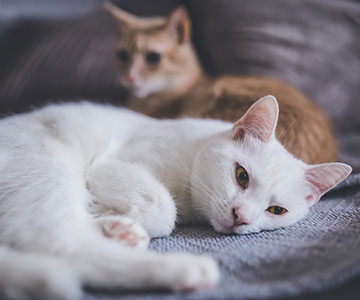
Find the right partner
Choosing the right partner requires sensitivity and consideration of the individual needs of both animals. A multi-cat household is ideal for indoor cats in particular, as the cats can spend time together, play and rest together. However, not all cats are suitable for each other, and choosing the right partner is crucial for the success of a reunion.
Every cat is an individual with its own preferences and behaviour. Nevertheless, there are some criteria that you can bear in mind:
- Age: Cats of a similar age are usually easier to bring together. A young animal can stress an older cat, while an older cat often cannot interact with a young animal in an age-appropriate way. Similar life stages make for a more harmonious life together.
- Character: The characters of the cats should match. A lively whirlwind is rarely the ideal partner for a cosy sofa cat. Make sure that the new pet has a similar temperament and social behaviour.
- Previous history: If a cat has had bad experiences with other cats, it may initially react anxiously or insecurely to a new arrival. Animals that have lived alone for a long time may also need more time to get used to company.
- Gender: Bringing two unneutered male cats together can be difficult, as they often perceive each other as competitors and conflicts are almost inevitable. Neutered cats — regardless of gender — are much more likely to live together peacefully.
- Handicaps: Cats with health restrictions require a considerate partner. A very active and dominant cat could be too much of a burden for an animal with a handicap. A gentler and calmer animal is often better suited to avoid stress.
- Lifestyle: Free-roaming cats can make reuniting difficult, as the new addition could be perceived as an intruder in the territory. However, harmony in the household makes it easier to let them out together.
- Siblings: Cats that have grown up together usually get on particularly well — their close bond often ensures a harmonious life together.
Tips for preparation
Thorough preparation is essential to make the new cat's arrival and first encounters as stress-free as possible. The focus is on creating an environment that meets the needs of both cats and gives them time to slowly get used to each other.
Each cat should have its own resources, such as food and water bowls, in different places to avoid competition. Equally important is the number of litter trays: at least one more litter tray than there are cats in the household is a good rule of thumb. You can find more information on this topic here. Cats are clean, and a lack of retreats or toilets can lead to conflict or messiness.
To enable cats to retreat when they need peace and quiet, the home should be equipped with sufficient hiding places and raised lying areas. These retreats are particularly essential during the familiarisation phase, as they allow the cats to observe their surroundings from a safe distance or to avoid each other.
Toys and activities also help to reduce stress and channel energy playfully.
Step by step to harmonious coexistence
Moving in a new cat requires a gradual approach so that both animals can get used to each other without being overwhelmed. Cats are sensitive animals that need time and patience to build up trust. These four steps will help you to optimise the process:
1. Step: Separating the cats
2. Step: Indirect familiarisation
3. Step: Getting to know each other with a protective barrier
4. Step: Getting to know the cats directly
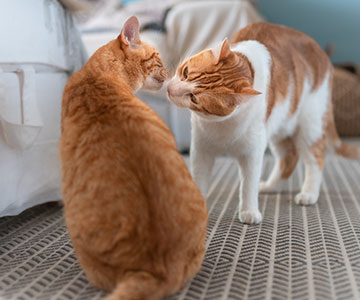 When sniffing, cats explore each other's odours and build up their social bond through olfactory communication.
When sniffing, cats explore each other's odours and build up their social bond through olfactory communication.
Phases of merging - From the first hiss to harmony
Rejection phase
Tolerance phase
Exploration phase
Coming together phase
Mistakes that should be avoided at all costs
Bringing cats together is a process that requires patience and understanding. Mistakes can make the familiarisation process more difficult and cause stress for everyone — but most of them can be easily avoided.
Impatience is one of the most common problems. Every cat has its own pace and some need more time to get used to each other. Don't force an approach — the relationship develops gradually.
The cat at home should not get the feeling of being “shunted off”. Consciously take time to cuddle and play with it and maintain its familiar routine. This strengthens their confidence and reduces jealousy of the new arrival. It can be helpful to make another person in the household the new arrival's carer so that the cat at home retains its familiarity.
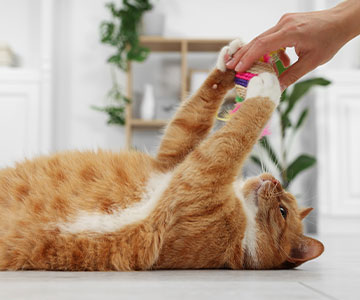
Scuffles such as hissing, growling or occasional pawing are part of the game as long as no cat is injured. Only intervene if the situation threatens to escalate. Give the cats space to clarify their boundaries themselves.
Cats need places to retreat to during this stressful time. Give a cat that withdraws the space it requires. Don't actively place it in front of the other cat, but wait until it approaches the new flatmate on its own.
Even if there are now two cats in the household, both still require your attention. Playing together encourages the dynamic, but make sure that neither cat is neglected.
Letting cats loose on each other unprepared often leads to stress. Good preparation — such as a separate room for the new arrival and a gradual exchange of odours — creates the basis for a successful reunion. Without these steps, cats quickly perceive the situation as a threat, which can intensify conflicts.
Mistakes can be avoided with well-thought-out planning and patience. Every little step forward is a success, and even a neutral cohabitation shows that you have done a lot of things right. Look forward to the positive moments that lead to harmonious coexistence!


 Deutsch
Deutsch
 English
English
 Nederlands
Nederlands
 Français
Français



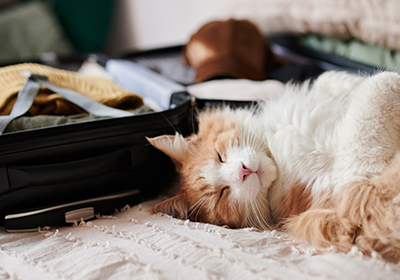

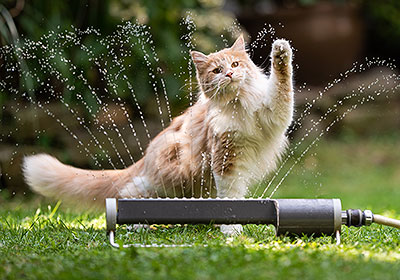



.png)
.png)
.png)

